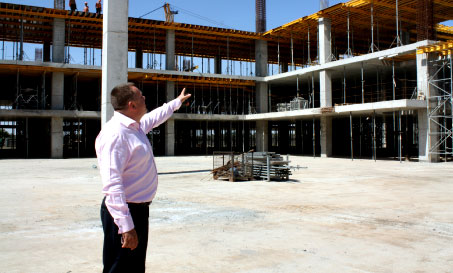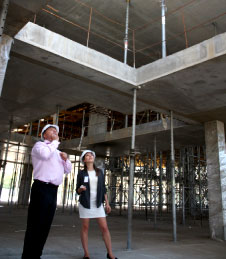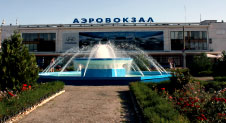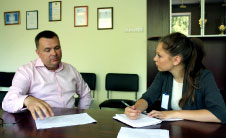
Odessa’s impressive new terminal is the first in its three-phase plan for expansion, which will eventually see the construction of two more terminals in the coming years. Architecturally conceived by Odessan design bureau Belyetazh, with a technological infrastructure devised by Spanish contractor Ineco, testing of the building will begin in May 2014, and in September the new terminal will begin handling all of the airport’s general aviation operations.
In the last year-and-a-half nine new airlines have begun regular services from Odessa International Airport, bringing the total number of carriers to have established operations at the enterprising regional hub up to around 15 since 2010. The airport is, in fact, experiencing exponential growth in every area of its operations, and continues to gather momentum, with passenger traffic in an upward spiral that shows no signs of slowing. In the seven months between January and July, Odessa Airport handled close to 580,000 passengers, a +19% increase on the previous year’s period. The +24% rise in passengers on international flights – to almost 480,000 – serving as a telling indication of the beguiling Black Sea port city’s soaring popularity with tourists, and with throughput expected to reach more than one million by the end of the year, passenger numbers have ballooned to far exceed its current capacity.

The €45 million, two-storey terminal will be 28,000sqm in size when it is completed – around three times as large as the previous structure – and have the capacity to handle more than two million passengers per year. The construction of the building’s concrete framework has already been accomplished, and now the entirely Odessan workforce has begun the installation of the roof and glass façade.
Now Odessa International Airport is redeveloping to meet the needs of its burgeoning passenger numbers, and enable the airport, and the city, to realise its full potential. Its impressive new terminal, implemented by the previous administration led by Oleksiy Kochanov (now Director General of Kyiv Boryspil), is in the active stage of construction, and, when completed, the cutting-edge infrastructure will provide an optimum environment for its consistently growing number of visitors and increasing airline business. Since his appointment to the role of Airport Director in August, Portyanko’s emphasis has been on developing a strategy that will exploit with maximum efficacy the state-of-the-art facilities that the airport will soon receive.

In August of this year Oleksandr Vilkul, Ukraine’s Vice Prime Minister and Chief of State Commission for Technogenic and Ecological Safety and Emergency Situation, confirmed that the construction of Odessa’s new 2,800m runway would begin towards the end of 2013.
“We hope that the new terminal will be one of the best in Europe, but we are aware that Europe is not standing and waiting – all of its hubs are developing too, developing new technologies and techniques and equipment,” Portyanko said. “Task number one for us is to generate new business areas; become a business field that will meet the needs of all of our current and future carriers. We have prepared for the possibility that our aviation climate will change – with more domestic flights, or a growth in transit flights for example – by implementing a model that allows for future development depending on the need of our airlines in five or 10 years, or more.”
Looking to the future
“We want to create a comfortable airport environment both for airline business and for our passengers – this is our main priority. Odessa is a very friendly and welcoming city, and we want to capture its essence in our new terminal,” Portyanko continued. Amongst locals of the airy, green resort region is a popular expression – ‘you can breathe in Odessa’ – the significance of which is encapsulated in the design of its spacious new airport. The €45 million, two-storey terminal will be 28,000sqm in size when it is completed – around three times as large as the previous structure – and have the capacity to handle more than two million passengers per year. The construction of the building’s concrete framework has already been accomplished, and now the entirely Odessan workforce has begun the installation of the roof and glass façade.

“Task number one for us is to generate new business areas; become a business field that will meet the needs of all of our current and future carriers. We have prepared for the possibility that our aviation climate will change – with more domestic flights, or a growth in transit flights for example – by implementing a model that allows for future development depending on the need of our airlines in five or 10 years, or more,” Portyanko said.
The new terminal will greatly enhance Odessa’s passenger processing capabilities. While currently inbound domestic passengers collect their baggage from a sheltered area outside of the airport, the new structure incorporates two baggage carousels in arrivals – one for domestic and one for international passengers – as well as 16 check-in desks, and the new airport will embrace new technologies in every aspect of its transformed passenger experience. “As we speak there is a commission in operation, a group of professionals who are developing new technologies for us, to cover all areas of the passenger process,” Portyanko explained. “We are not looking at today’s technology but are looking towards the future, looking to develop and acquire those technologies that will be used tomorrow. Our focus at this point is on adopting automated check-in processes, and at present we are looking at implementing the best facilities for self check-in and self bag-drop. We want to be at the forefront of aviation, and the future is the direction we are headed in.” Preparation for the future is at the crux of Odessa’s extensive expansion strategy, and when operations begin the transition from the old to the new terminal from May to September next year, the first stage of the development will be complete. It is planned that in the coming years two more terminals will also be incorporated into ODS’ broadening infrastructure.
Construction is also soon to begin on the airport’s new runway. At 2,800m in length, it will be capable of accommodating aircraft of all types including, for the first time, large long-haul craft. “Now we have a brand new terminal in the active phase of construction, and a runway about to be, we need to continue in this direction, and need to work on developing our air passenger traffic and routes in accordance with this growth,” Portyanko said.
‘The instruments for major development’

Portyanko: “We want to show airlines that there is interest from passengers, and therefore airlines, all year long. We have constant traffic all year round, not only tourism in summer but business activities and transit traffic to Europe and Russia.” The airport is currently in daily negotiations with airlines including Lufthansa and S7 on increasing the frequency of their routes, as well as an array of new carriers on establishing services from Odessa.
The new terminal will engender a multitude of new opportunities for Odessa, and is the key the continued prosperity of the airport and the region. Portyanko explained that the onus now falls to he and his team to demonstrate to airlines and passengers the clear potential that Odessa has to offer. A principal aspect of his plans for development is to establish Odessa not only as a seasonal airport, popular with tourists in the summer months, but as a key network destination all year round.
“We want to show airlines that there is interest from passengers, and therefore airlines, all year long. We have constant traffic all year round, not only tourism in summer but business activities and transit traffic to Europe and Russia,” Portyanko said. The airport is currently in negotiations with Lufthansa on the initiation of a year-round schedule of flights that includes daily services in the winter. Siberian airline S7 meanwhile has increased the frequency of its Moscow Domodedovo to a daily service, and flydubai has launched a Dubai International route. “We welcome the new carrier and we are very happy that it is here. We hope it won’t only be seasonal, but that it will offer flights all year round,” Portyanko said.
In his first few months as Airport Director, continuing to expand the airport’s route network and develop more frequent domestic and international connections is high on Portyanko’s agenda, and correspondingly, interest from carriers in Odessa continues to swell. The region is over-spilling with touristic opportunity, boasting one of Europe’s best-loved opera houses, and as it continues to blossom there is growing demand among passengers for connections to the city. Portyanko is now in the process of developing its two-way model of cooperation, with benefits to further enhance its relationship with new and existing airlines, and with the modern infrastructure that will be brought to the airport by the new terminal, at Odessa the pieces are in place to fulfil major future market demand.
“It is now 22 years since the day of liberation when Ukraine gained its independence, and lots of new airports have been opened in recent years – big projects that are not just promises; they exist and they work, they have very good infrastructures and they can offer a lot to airlines and to passengers. In Ukraine we now have the instruments in place for major development, for growing our number of routes, carriers and passengers as well,” said Portyanko. “Now, for Ukraine’s airports, open skies is the foremost factor that will affect our further development. Our Ukrainian airlines may well be concerned that open skies will increase competition with Western carriers, but that is where our new model of airline-airport cooperation will come into play, and will help to develop both markets, to develop airlines and routes and traffic for the airport,” he concluded.







